Pickleball Serving Rules: Master the Art of the Serve and Start Your Point Strong
The serve is the crucial first shot in pickleball, setting the tone for the point. Understanding the Pickleball serving rules is essential for both singles and doubles players, as it allows you to start the game confidently and strategically. While the pickleball serve may seem simple at first, there are some nuances and specific rules that players need to know to avoid committing a fault and ensure a successful start to the point.
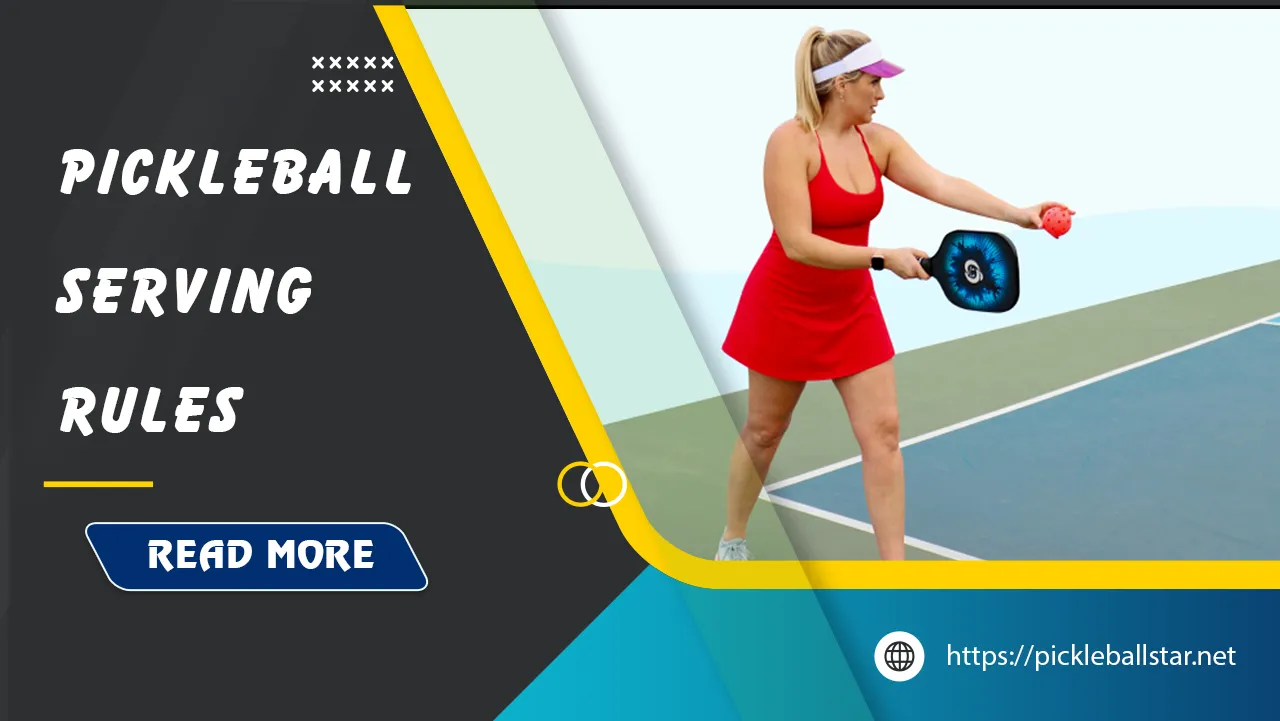
Basic Pickleball Serving Rules
Serving in pickleball is more than just hitting the ball over the net; it requires a clear understanding of several key elements that make up a legal serve. Let’s delve into these fundamental rules.
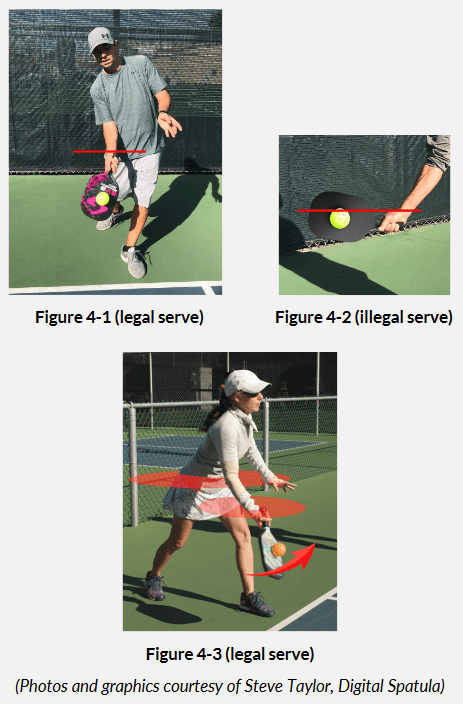
Server’s Arm Movement
In pickleball, the server’s arm movement must follow a strict upward trajectory. Unlike tennis, where you can deploy a powerful overhand serve, pickleball requires a more refined and controlled motion. The server’s arm should move in an “upward arc” at the moment of impact. This rule ensures that the serve remains manageable and accessible for players of all skill levels. Think of it like painting a smooth, upward stroke with a brush the motion should be fluid and deliberate, embodying both grace and precision.
Paddle Contact with Ball
Another critical aspect is where the paddle contacts the ball. According to the official rules, the ball must strike the paddle below the waist. Specifically, the paddle itself must be below the server’s wrist at the point of contact. This ensures that the serve remains consistent with the underhand structure of the game. Imagine trying to scoop a low ball with a shovel; the paddle must act similarly, keeping below your midsection to avoid a fault.
Paddle Head Position
The position of the paddle head is crucial for a valid serve. The entire paddle head must be lower than the wrist. This position forces the server to focus on control and technique rather than raw power. Picture holding a mallet lower than your wrist while gently tapping a ball forward; the action requires finesse and accuracy, which are central to the serving rules in pickleball.
Drop Serve Rules
The drop serve also known as the bounce serve is a relatively new addition to the game, introduced permanently in 2022. This serving method involves dropping the ball and hitting it after it bounces at least once. Here are some specific rules for the drop serve:
- One-handed release: The ball can only be dropped from your hand or paddle.
- Natural height: There’s no limit on how high you can hold the ball before dropping it.
- Bounce first: You can only hit the ball after it bounces at least once.
- Visible release: The receiver (and referee, if present) needs to see the ball when you release it.
- Regular footwork: You still need to have one foot behind the baseline, not touching the court or baseline, and cannot extend into the sideline or centerline.
- No added force: Gravity is your only friend here. You can’t throw the ball down or toss it up before the bounce.
- Forehand or backhand: Once the ball bounces, you can hit it with either a forehand or backhand swing.
Server’s Foot Placement
Proper foot placement is paramount in pickleball serving. The server must ensure that at least one foot remains behind the baseline until the ball is struck. Moreover, the server must avoid touching the court or the lines, sticking strictly to the imaginary extensions of the center line and sideline. Imagine standing at the edge of a cliff you wouldn’t dare to cross the boundary; the same cautious approach should be adhered to when ensuring your footwork is within the legal limits.
Serving Diagonal Crosscourt
Each serve needs to be made diagonally crosscourt, meaning the ball should land within the designated service area on the opponent’s side. This rule promotes fairness and challenges the server to aim accurately. Visualize a diagonal cut across a cheese wheel; the cut must be precise, achieving a fair split across the intended area.
Serve Attempt Limit
The serving team is allowed only one serve attempt per turn. This simplicity keeps the game moving swiftly, focusing on continuous play rather than repeated attempts.
Integrating these basic rules ensures a standardized and fair approach to serving, making pickleball enjoyable and accessible for all players.
Serving Sequence
Understanding the serving sequence is vital for maintaining the flow of the game, especially in doubles, where the rules can be a bit more convoluted. Let’s break down the serving sequence in both singles and doubles play.
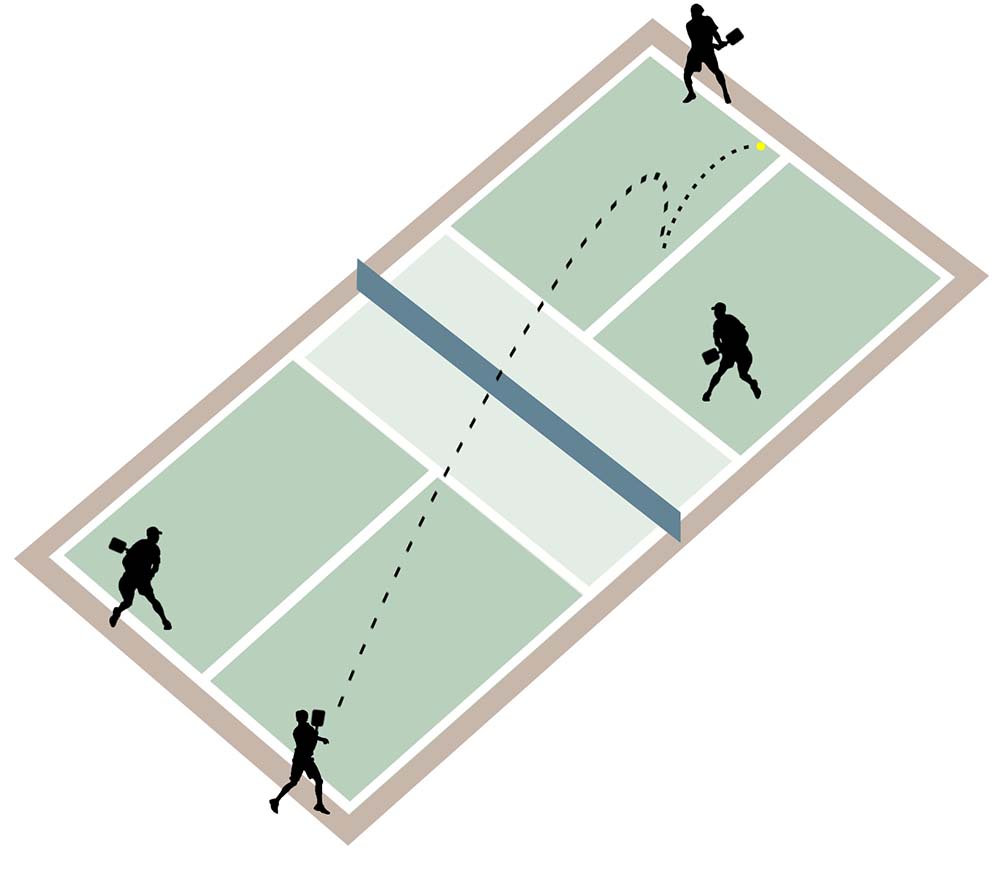
Doubles Serving Sequence
In doubles, both players on the serving team have an opportunity to serve before losing the chance to the opposing team. Here’s how it works:
- The first serve always begins from the right/even court.
- If a point is scored, the server switches sides and serves from the left/odd court.
- The server continues switching sides after scoring each point.
- Once a fault is committed, the serve is transferred to the second server on the same team.
- The second server follows the same sequence, starting from the right/even court.
- After both players have served and committed a fault, the serve is passed to the opposing team.
This alternating sequence ensures that both players are actively involved in serving, adding an extra layer of strategy and coordination.
First Serve of Each Side-Out
At the start of each side-out (when a team regains serve), the first serve is always initiated from the right/even court. This rule simplifies the game’s flow and ensures consistency in initiating serves.
Serving After Scoring a Point
After scoring a point, the server must always switch sides with their partner. This switching keeps both players dynamic and ensures no bias in favor of one side. The serve then continues from the appropriate side based on the current score right/even if the score is even, and left/odd if the score is odd.
Singles Serving Sequence
For singles play, the serving sequence is straightforward but strategic:
- The serve always begins from the right/even court at the start of the game.
- If the server’s score is even, they serve from the right/even court.
- If the server’s score is odd, they serve from the left/odd court.
- After each point, the server switches sides based on their score.
- When the server loses the rally or faults, the service passes to the opponent, who then repeats the sequence.
Point Scoring
In the game of pickleball, understanding the scoring rules is fundamental:
- Points can only be scored by the serving team.
- Each game is typically played to 11 points, with the winning team needing a margin of 2 points.
- The score is always called out before each serve, stating the serving team’s score, the receiving team’s score, and the server number (in doubles play).
Game Length
- Standard games are played to 11 points, but tournament games can extend to 15 or 21 points.
- Tournaments might have different rules for game length, possibly requiring a best-of-three format.
Tournament Game Length and Scoring
Tournament matches often follow a best-of-three format and may extend the point count to 15 or 21, still requiring a two-point win margin.
By mastering these serving sequences and scoring rules, players can ensure smooth and strategic gameplay, maximizing their chances for success.
Two-Bounce Rule
The two-bounce rule, also known as the double bounce rule, is one of the unique aspects of pickleball that adds a layer of strategy and fairness to the game. Here’s a deeper dive into this crucial rule.
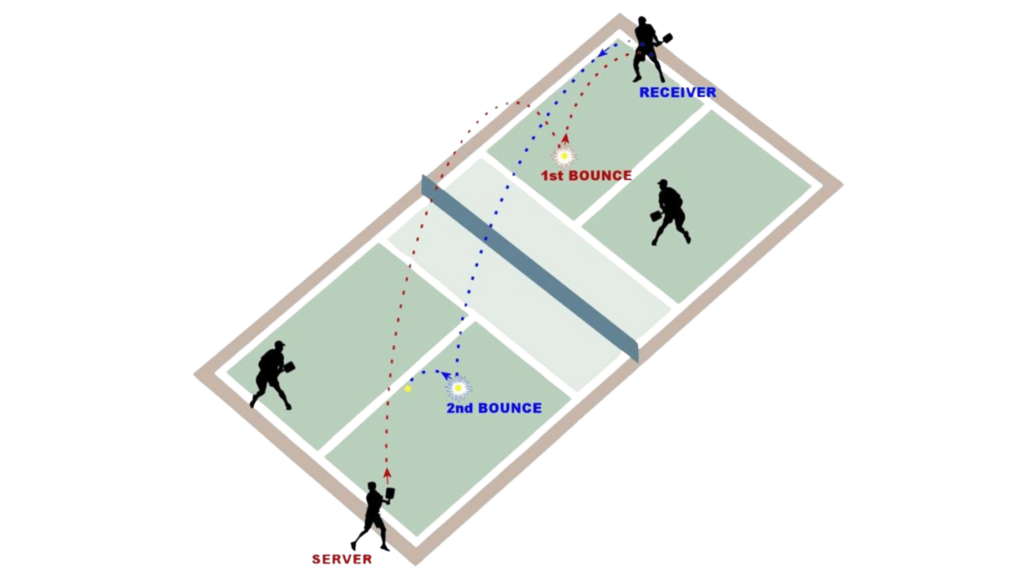
Receiving Team’s First Bounce
When the ball is served, the receiving team must let it bounce once before returning it. This initial bounce ensures that the serve isn’t aggressively attacked, giving the serving team a fair chance to prepare for a rally.
Serving Team’s First Bounce
After the receiving team returns the serve, the serving team must also let the ball bounce once before hitting it. This second bounce levels the playing field, preventing any team from gaining an unfair advantage through immediate volleys.
Volleying or Ground Stroke After Two Bounces
Once both the serving and receiving teams have allowed the ball to bounce once, the ball can then be played either as a volley (hit in mid-air without bouncing) or as a ground stroke (allowing the ball to bounce). This rule opens up the game to more dynamic play styles and strategic shot-making.
Line Calls
Line calls in pickleball must be precise to ensure fair play. Understanding when the ball is “in” or “out” is crucial.

In-Bounds Ball Contact with Lines
Any ball that lands on the boundary lines (sidelines, centerlines, and baselines) is considered “in.” This rule ensures that players have a clear understanding without needing to check distances closely.
Short Serve Fault
A short serve, where the ball lands within the non-volley zone or on the non-volley zone line, results in a fault. Players need to ensure their serves are deep enough to clear this area.
Non-Volley Zone
The non-volley zone, often called the “kitchen,” is a 7-foot area extending from the net on both sides. This zone has specific restrictions to maintain fair and strategic play.
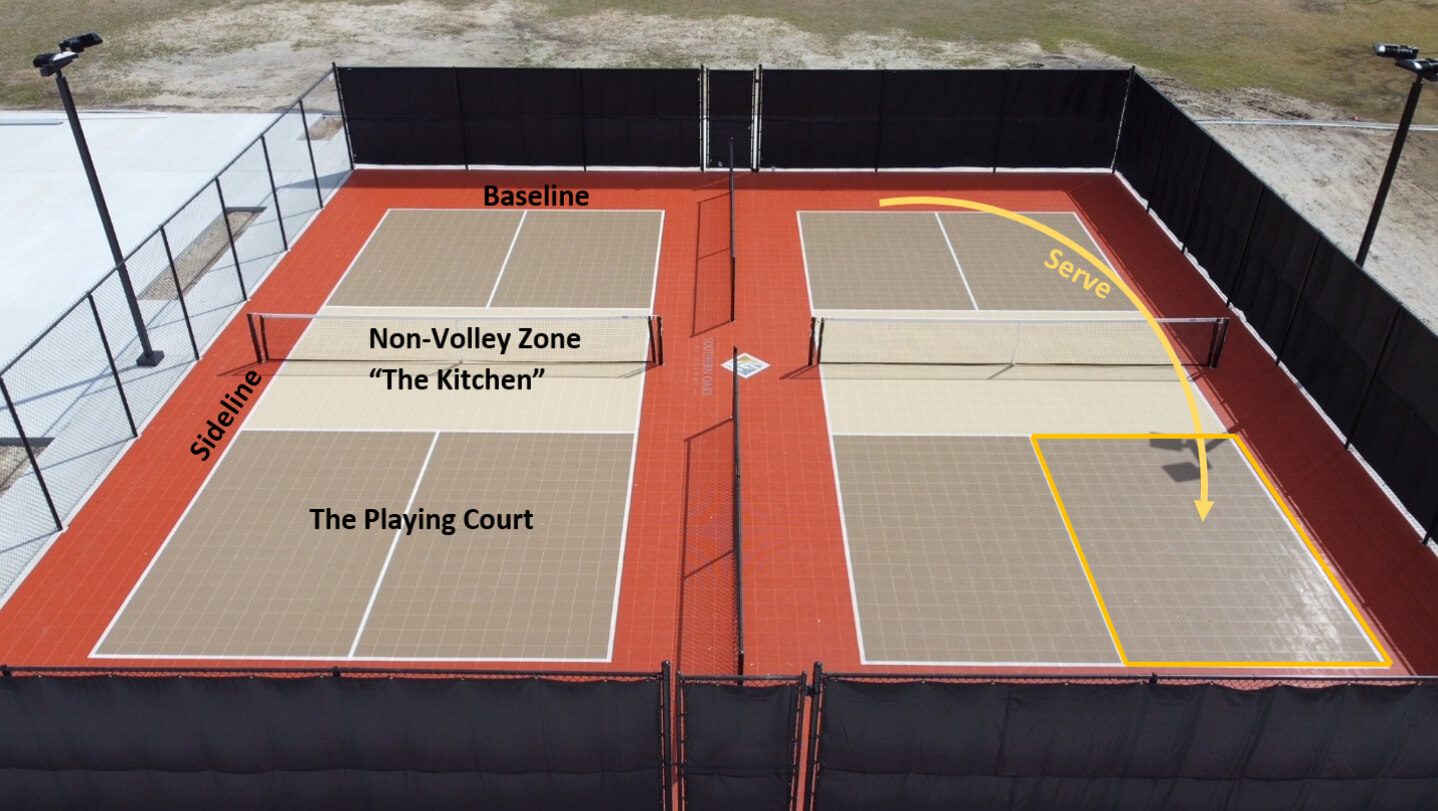
Non-Volley Zone Definition
The non-volley zone is a defined area adjacent to the net where players cannot volley the ball. This prevents dominating the game with smashes right at the net.
Volleying in the Non-Volley Zone
Volleying in the non-volley zone hitting the ball in mid-air without allowing it to bounce is strictly prohibited. This rule encourages players to use groundstrokes within this area rather than aggressive plays.
Stepping on the Non-Volley Zone Line
Stepping on or over the non-volley zone line while volleying results in a fault. Players must be cautious about maintaining their position.
Momentum into the Non-Volley Zone
Even if a player avoids stepping into the non-volley zone while hitting a volley, their momentum carrying them into the zone afterward still constitutes a fault. This rule ensures players remain precise and controlled in their movements.
Legal Presence in the Non-Volley Zone
Players can stand within the non-volley zone as long as they don’t volley. This presence might be used strategically, awaiting a shot that they can play off a bounce.
Faults
Both the receiving and serving teams must avoid faults to maintain their respective advantages.
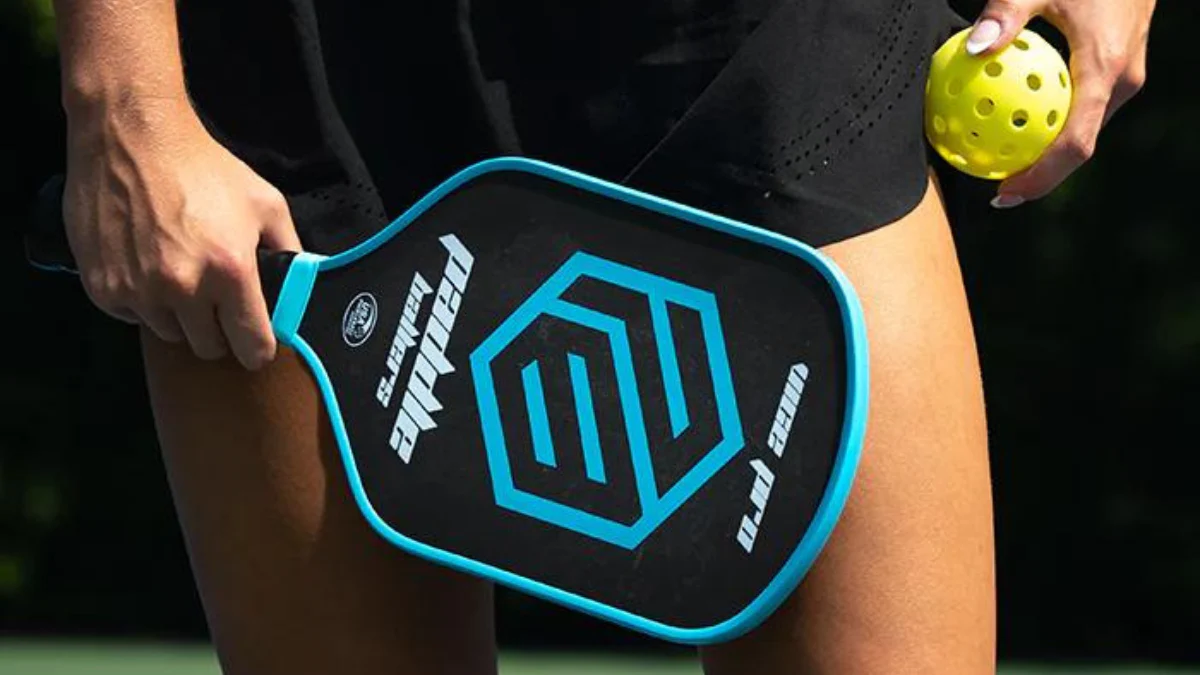
Receiving Team Fault
Common faults for the receiving team include:
- Hitting the ball out of bounds.
- Failing to let the serve bounce before returning it.
- Hitting the ball into the net.
These faults result in a point for the serving team.
Serving Team Fault
Common faults for the serving team include:
- Serving the ball into the non-volley zone.
- Failing to let the return of serve bounce.
- Stepping on or over the baseline during the serve.
These faults result in losing the serve to the opponent.
Determining Serving Team
To determine which team serves first, players can use several methods:
- Coin Flip: A simple yet effective method.
- Discussion: Players mutually agree on who will serve first.
- Facility Rules: Some facilities have preset rules about serving, simplifying the decision.
Whether it’s a coin toss or a specific house rule, determining the serving team ensures a fair start.
Common Questions
Can I serve a pickleball overhand?
No, pickleball serves must be underhand. The rules strictly mandate that the paddle must be below the server’s waistline at the point of impact.
What is a “double fault” in pickleball?
A double fault occurs when a team commits two consecutive serving faults, usually resulting in a side-out.
What are some common tips for improving my pickleball serve?
- Practice Consistency: Focus on control rather than power.
- Use the Drop Serve: Especially useful for beginners, as it adds an element of predictability.
- Aim Strategically: Target weak spots in your opponents’ court.
How does pickleball serving differ from serving in tennis?
Unlike tennis, pickleball requires an underhand serve, making it a more controlled shot. The ball must also remain below the waist at contact. Additionally, the two-bounce rule and non-volley rules introduce unique aspects of gameplay not found in tennis.
Conclusion
Mastering the serve is crucial for success in pickleball, and by understanding the pickleball serving rules and practicing your technique, you can start each point with confidence and a strategic advantage. It’s not just about sending the ball over the net but doing it with precision and purpose. Indeed, a strong serve is the foundation for a successful game.
Whether you’re a newcomer or a seasoned player, practicing your pickleball serve and learning the rules can elevate your game to new heights. So, grab your paddle, head to the court, and get ready to serve up some great pickleball!
